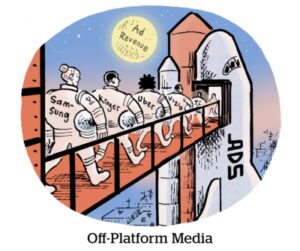Here’s today’s AdExchanger.com news round-up… Want it by email? Sign up here.
Insta Needs Its Groove Back
Instagram has (mostly) been able to balance its business priorities with the interests of its users.
But its streak is over.
Instagram is struggling to recruit people to create content for its TikTok clone, Reels, The Wall Street Journal reports, and Reels sees less than one-tenth of TikTok’s daily viewing hours.
Last month, Instagram CEO Adam Mosseri addressed complaints about the app’s transition to video and even acknowledged that it had “gone too far into video.”
Last month, Facebook folded its live-shopping video product, and this month Instagram shut down its affiliate commerce program.
That’s not great news for Meta. Commerce and video are business imperatives, and gains in either category generate outsized returns for Meta’s ad platform. But it’s just not working on Instagram.
Video apps are fundamentally different from photo- and text-based social media. Consider YouTube and TikTok versus Instagram and Pinterest versus Twitter and Reddit.
Maybe Instagram just doesn’t have the bones to be a commerce app. Maybe it needs to stay a photo-sharing app that has a strong influencer affiliate play. We’ll see how it shakes out.
But with all Meta’s problems, including its first-ever YoY revenue decline in Q2 since going public, can Meta afford to let Instagram just be Instagram?
Starved For Attention
Attention-based advertising metrics have been around for almost a decade now. But the idea is finally gaining a toehold in the market – or at least there are more attention metric startups on the scene now, and agency buyers are more inclined to transact on attention metrics.
Why now? Marketers are starting to realize that some of the main programmatic metrics they’ve come to rely on – viewability, for instance, and click-through rate – are gameable. Publishers bunch ads at the top of the page and load ads before the content loads to secure good viewability scores, while CTR is practically irrelevant for many brands.
Attention metrics are a way to measure value based on whether an ad was both seen and resonated with the person who saw it.
Another sign of maturity for the category is that the Advertising Research Foundation has launched an Attention Validation Project, reports Broadcasting+Cable.
And some parties are even pushing for incorporating attention-based metrics into “next-generation currencies for media buying,” said Scott McDonald, the ARF’s CEO and president. But it’s too early for that, according to the ARF.
“It is the ARF’s view that these discussions of attention-based currencies are premature in the absence of better information on the validity, reliability and predictive power of these measures,” McDonald said.
Could DALL-E Write WALL-E?
Newspapers thought their value came from intrepid reporting and prose. In fact, newspapers owned a distribution bottleneck between printing presses and morning paper delivery. When the internet exploded, every local paper was suddenly in competition for ad dollars with the biggest names in publishing, writes Ben Thompson at Stratechery.
And writers aren’t sheltered from this trend, either.
Stock and commercial image production, graphic design and a slew of other creative content roles may be on the same sorry trajectory as the local newspaper business.
“If the connection between idea creation and idea substantiation is being severed, it seems reasonable to assume all attendant business models might suffer the same fate,” Thompson argues.
But there are some benefits for creators when it comes to the democratization of AI. One is that at least they’ll have access to free and abundant content they can use for themselves. (AI-prompted content is still unique, after all.)
The second rejoinder, however, is perhaps “more grim,” Thompson says, which is that “this is going to happen regardless.”
AI-generated images will “soon be a flood,” he writes, “just as publishing on the internet quickly overwhelmed the old newspaper business model.”
But Wait, There’s More!
Private-equity firm Bridgepoint is set to take a majority investment in MiQ at a $1 billion valuation. [Insider]
Netflix may change its binge-style viewing to weekly episode releases. [Puck] In other Netflix news, it’s teaming up with Ubisoft to produce three exclusive games. [Kotaku]
Online prices in the US jumped 2.1% in August, led by a price surge in groceries. [Bloomberg]
As ad budgets are slashed in the absence of cash, marketers are striking “bartering” deals with influencers. [Digiday]
You’re Hired!
The IAB Tech Lab promotes Shailley Singh and Jill Wittkopp. [release]
Integrate names John Gurski as its new president and CRO. [release]
Kraft Heinz appoints Diana Frost as chief growth officer for North America. [release]
Mozilla hires Carlos Torres as its chief legal officer. [release]
Audacy adds Terri Gunnell as EVP of advertising technology, products and platforms. [RadioInsight]

















